Last year I tested out a KeyMod hand guard from ODIN Works that I really enjoyed. While perusing their website, I noticed that ODIN sells barrels of their own creation as well. I filed that away in the memory bank until I was sitting around discussing barrels with some fellow writers at an event. One of the them raved about how good his ODIN barrel was. That stepped up my interest to “intrigued”. . .
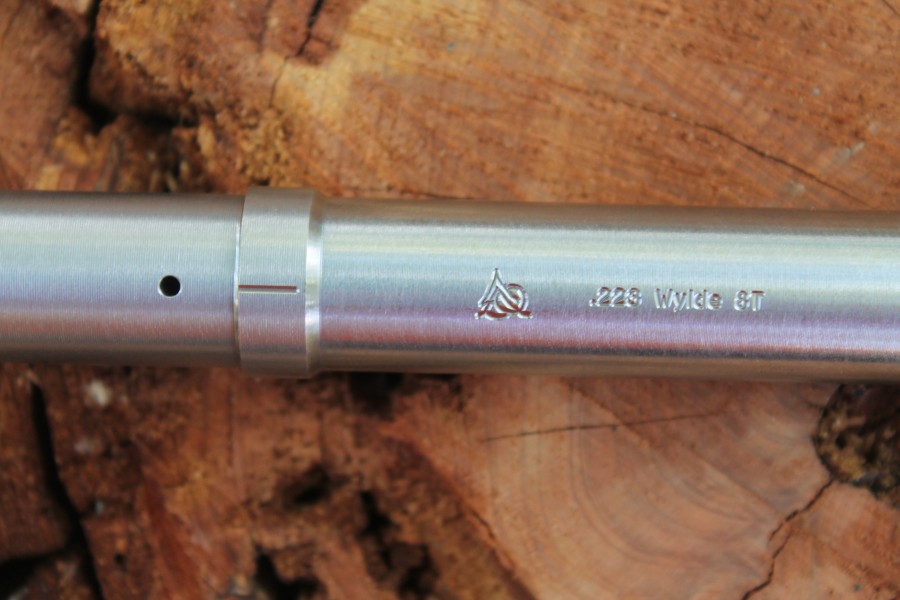
AR 15 barrels come in a variety of profiles, twists, lengths, and chamberings. At some point, analysis paralysis sets in and you just hit the “buy now” button and hope for the best. Or at least that is how this barrel ended up at my front door. This particular barrel is a 16.1″ length sporting 1:8 button rifling. The chamber is cut for .223 Wylde and the gas system is an intermediate length. The intermediate gas length is a bit longer than a mid length, but shorter than a rifle length system. The ODIN barrel is made from 416R Stainless and is hand lapped before leaving the factory.

I like a sixteen inch barreled AR 15. I think its a fine blend between paperwork and performance. The little .223 pills need velocity to do their job, and while I certainly wouldn’t stand downrange of a SBR firing 5.56/.223 at me, I prefer to get what “zip” I can. The NFA makes that decision a bit easier as well. I also find myself wanting a gun that is mechanically accurate and reliable. First, I test a lot of gear as a writer for TTAG, and I want to eliminate the gun as a variable in that testing. Second, I’m not a pro shooter, so I’ll take what advantages I can get.
As more of a shootability “want”, I like a soft shooting gun. There’s a lot that can be done with muzzle devices, but softening the impulse created when the bolt travels rearward can do wonders as well. I’ve never put Jeremy’s recoil sled to the task, but I generally feel like carbine length gas systems beat me up a bit more than mid length systems. Rifle length systems have always felt the softest to me. While I didn’t actively seek out ODIN’s intermediate length gas system, I’m not displeased by it being there.
The last thing that I really care about is a barrel profile that is heavy enough to keep flex, heat related or not, to a minimum. To a certain point, more material means more strength. I like the profile of ODIN’s barrel quite a bit for those reasons. I don’t really like carrying more weight around than I have to, but I put that rule aside for barrel weight if it drives accuracy or otherwise.

With all that in mind, the ODIN barrel seemed like a pretty natural fit. They could have taken the contour of the barrel down a bit after the gas block, but I assume that would have only saved a couple ounces. Out of the box, it is apparent that ODIN cares quite a bit. There are rubber plugs on either end of the barrel, it comes back in a sturdy plastic tube, and was wrapped in a great deal of bubble wrap.
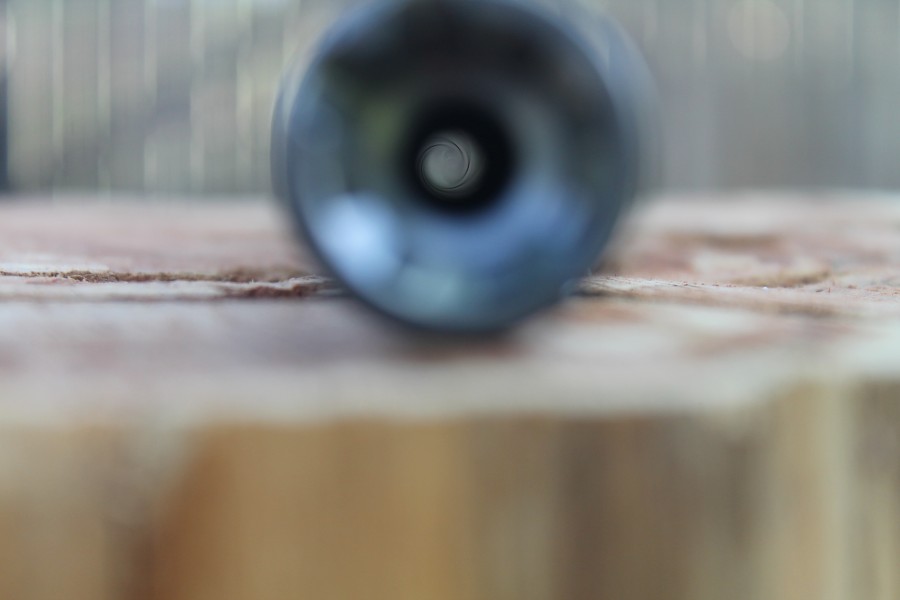
Closer inspection revealed a finely finished barrel with clean cuts on the muzzle threads, and the same on the gas port. I was pleasantly surprised to find an index mark on the barrel that showed the exact position of the gas port. That made lining up the gas block a cinch. Peering down the bore, sunlight reflected brilliantly off highly polished lands lending credence to the claim that these barrels are hand lapped before leaving the factory.
Normally, I would include a section about installation, but with a barrel, its all sort of the same. Without much fanfare, the ODIN barrel found itself attached to my Palmetto State upper, and riding under a BCM KMR. The only thing I will note is that I opted to throw the low profile gas block that ships with the barrel in the parts bin in favor of an adjustable unit from ODIN. Enough about that, let’s talk about the important stuff, accuracy.
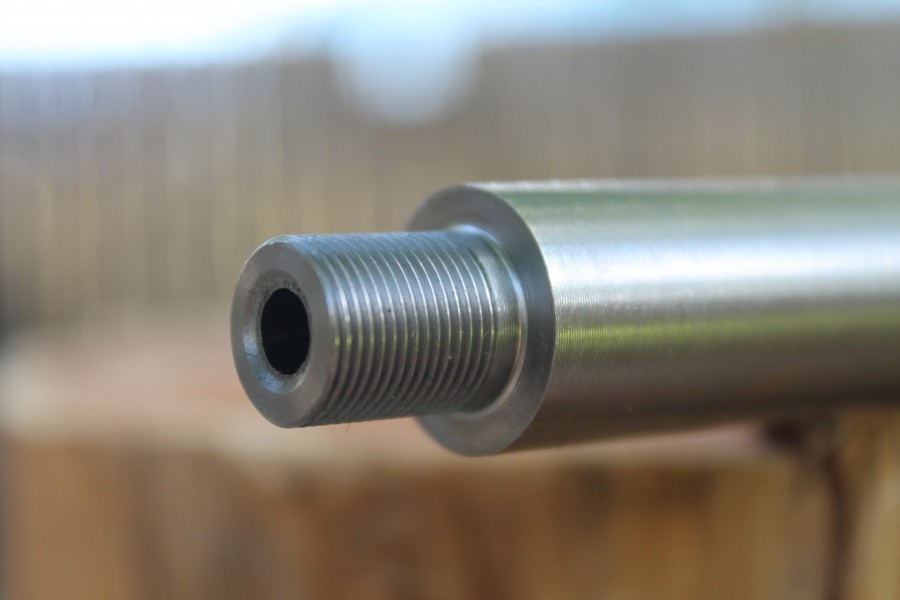
ODIN makes a 1 MOA guarantee on this gun. Let me pause. ODIN makes a 1″ MOA guarantee for this barrel. Somewhere, Nick is groaning loudly. That’s a bold (and confusing to the nerdy) guarantee from a manufacturer, but it comes with a big “out” in that they didn’t list a testing protocol for that number. So I loaded up my sandbags and my graph paper and an assortment of 5.56 and .223 REM ammo in various weights and headed for my local indoor range. Lucky for me, I was the only shooter that day so I wasn’t flinging fliers like I normally do.
For the test, I mounted up the ever excellent Bushnell DMR, fitted my newly assembled upper to a Palmetto lower with a Timney Trigger, and got to work setting up my front and rear rests. Once in place, I worked through a box of PMC bronze getting the gas system dialed in, and properly fouling up the barrel. With the optic zeroed, and the gas system running like a top, I started shooting for five shot groups. In order of worst to best, I give you scans of my targets after being run through OnTarget.
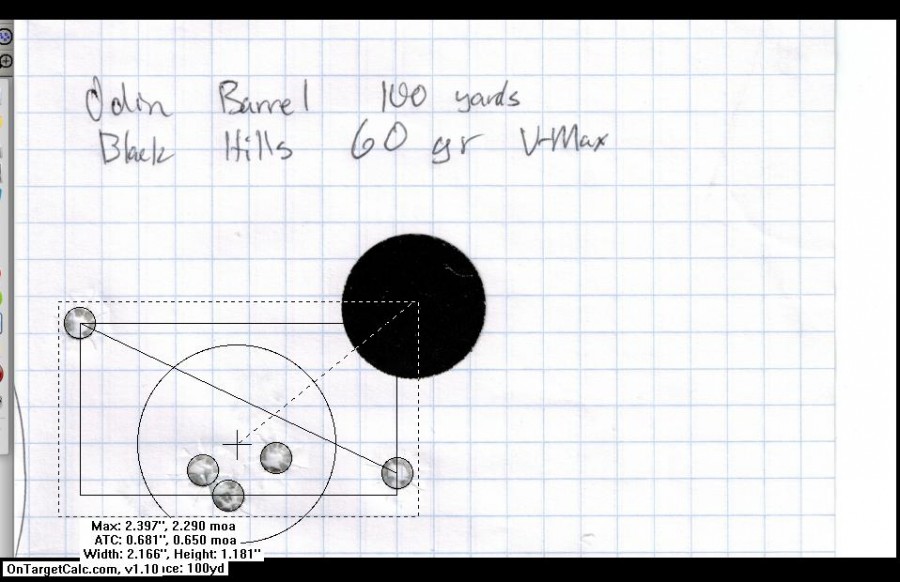
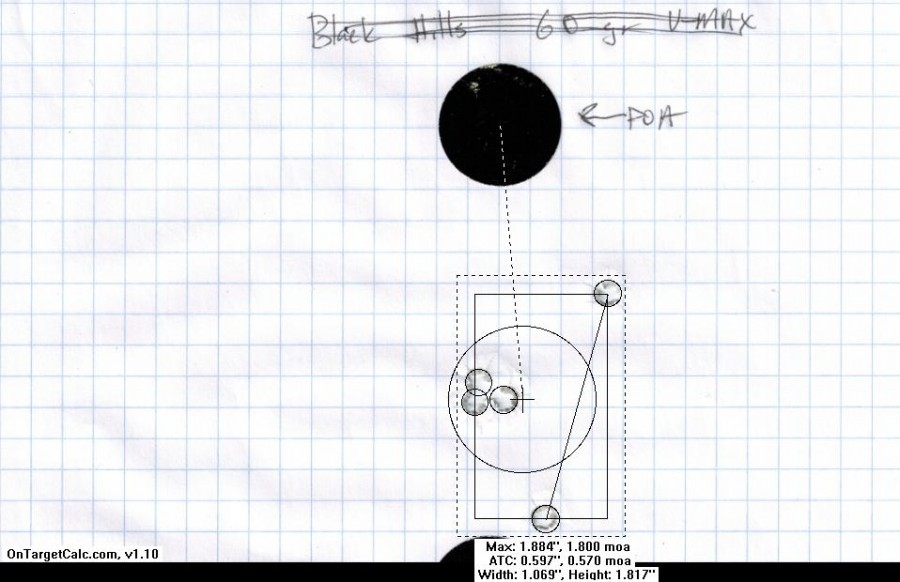
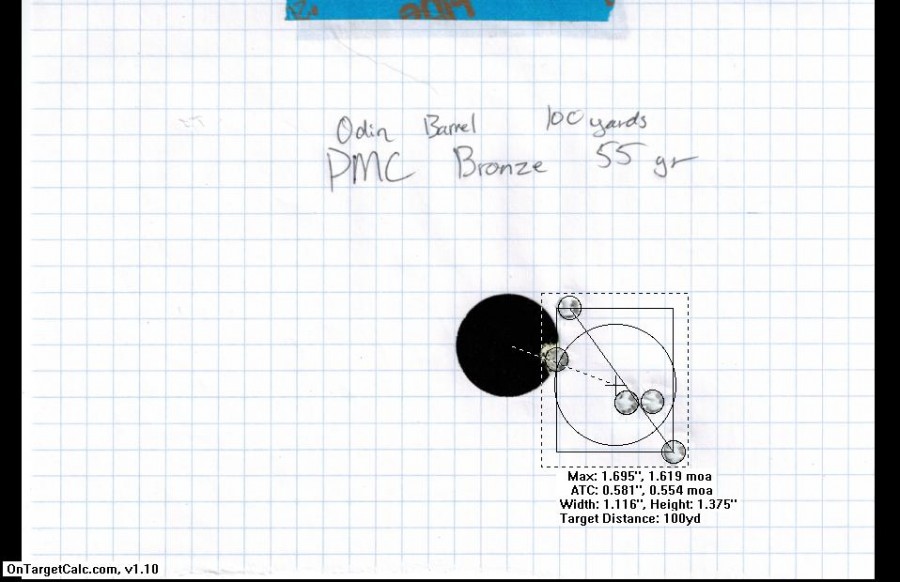
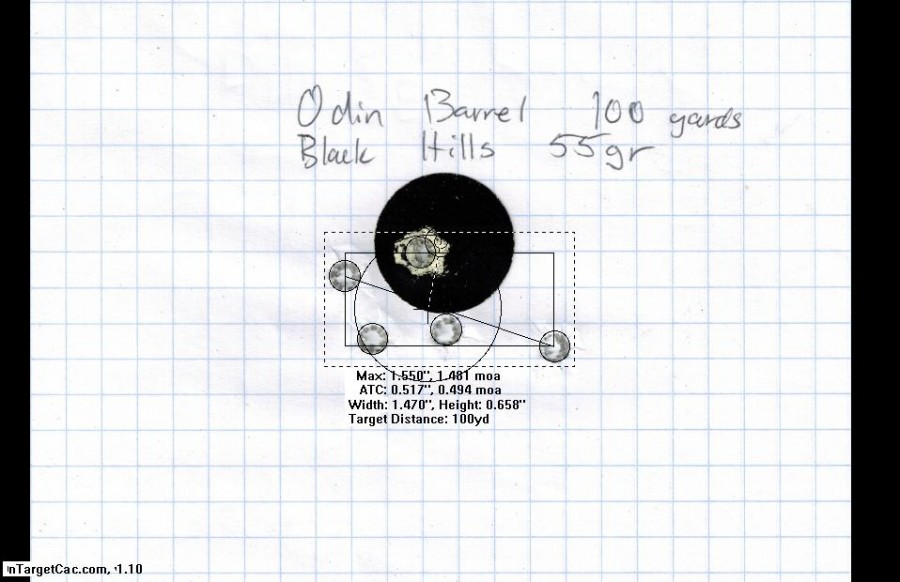


A sidenote to some of our more critical readers. I full recognize that it looks like 4 shots in the lower 69 gr. target and 3 shots on the upper 77 gr. target. Those are both five shot groups. I was equally puzzled when I pulled those targets back. I was slightly disappointed to see that the 55 gr. stuff didn’t stabilize nearly as well as the 69 gr. and 77 gr. ammo did. I might search around for a different 55 gr. it likes better. Or I might just shoot up the rest of this PMC Bronze to see if it “settles” in with shooting and cleaning. One thing is for sure, fed the right ammo, this this is a tackdriver, assuming that tack is roughly one inch in diameter, and you’re only 100 yards away.
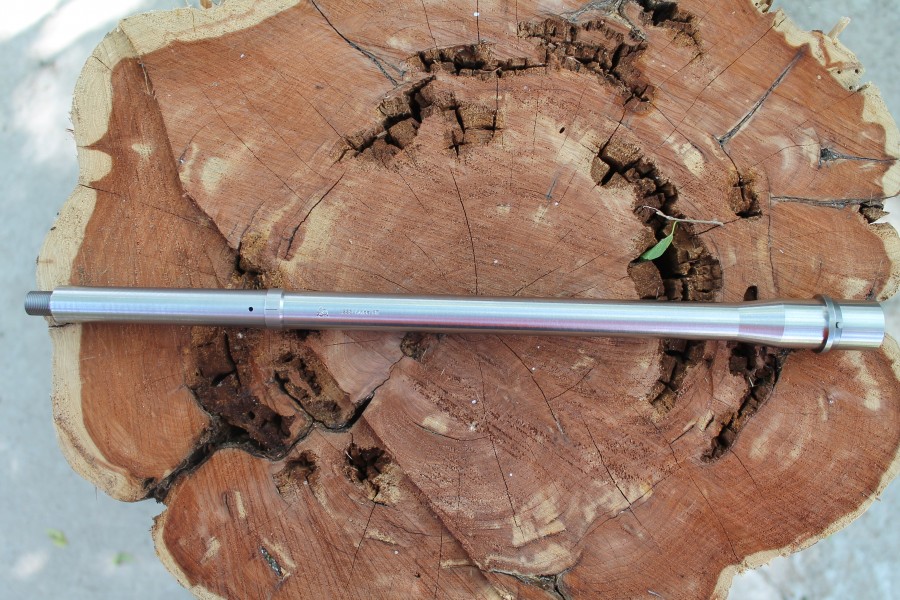
Specifications: ODIN Works 16.1 inch Intermediate Barrel
- Profile: Medium
- Length: 16.1″
- Gas placement: Intermediate
- Rifling: Button 1:8 twist
- Advertised Weight: 1.95 lbs
- Measured Weight: 30.95 oz – 1.93 lbs
- Material: 416R Stainless Steel
- Hand-Lapped
- M4 Feed ramps
- 1/2-28 Threading
- Included Parts: Low Profile Gas Block, Gas Block Hardware, Intermediate Length Gas Tube
- MSRP: $290
- Street Price: ~$275
Ratings (out of five stars):
Fit, Finish, Build Quality * * * * *
The ODIN barrel is packaged well and delivers a level of quality that the price tag commands. There are no machining marks, burrs, or blemishes. It fit my upper perfectly, and lined up with the gas system properly. The bore was polished to a mirror finish.
Ergonomics * * * * *
Fitted to a milspec upper and lower, with a BCM KMR handguard, Magpul BUIS, and a Magpul MOE Carbine Stock, the rifle has a balance point every so slightly forward of the front takedown pin with the stock collapsed, and slightly rear of that point with the stock expanded. For what a lot of users would consider to a be a heavier barrel, I found this to be a pleasing outcome as I like a bit of rearward balance
Accuracy * * * *
Ideal accuracy would something that would stack shot after shot, but this barrel certainly has a pet load. I came into this review hell bent on proving ODIN wrong on their 1 MOA guarantee but I found that with heavier weight, premium ammunition, I was able to put five shots under 1 MOA at 100 yards. For those times when costs wins out over ultimate accuracy, I can tolerate <2 MOA performance from cheap plinking ammo. If I were a cheating man, I could take the three closest shots of any of these groups and claim that the barrel does sub MOA performance with ease. But that wouldn’t be fair.
Overall * * * *
This barrel sits on the slightly higher end of average as far as barrels go. Keep in mind that a similar Noveske barrel with gas block and gas tube is currently selling on Midway for $450. Budget barrels are still ~$150 and don’t include the gas block or tube. Yes it is more expensive than the cheapest option possible, but it also delivers great build quality, thoughtful design considerations, and completely acceptable accuracy. There’s more testing to be done relative to long term performance, but at the moment, I’m in the camp of the aforementioned journalist fanboy. This is a great barrel.

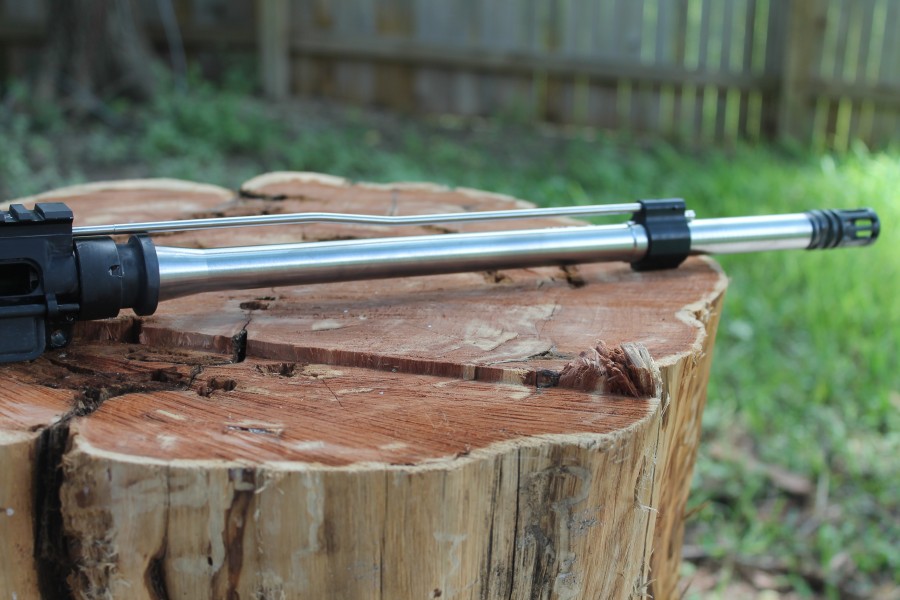



416 Stainless and that MOA for $275 is actually a pretty good deal.
As a side question – did you headspace it after assembling? I read different things on the need to headspace. Some say Yes, some say No, some say “what does it matter? the headspace is fixed”.
I did not. I used a known good bolt, and I took a bit of risk figuring that a company that hand laps a barrel is probably not going to send an out of spec product my way. Risky sure, but I was using known quality components, so I felt safe(ish).
I like the profile, and the accuracy is definitely there. I’ll look into Odin products for my next build.
Safe(ish). I LMFAO at that. 😀
Been there, done that, with a “known good bolt”. Not exactly confident on the first trigger pull. Now I just buy a new bolt.
http://www.brownells.com/gunsmith-tools-supplies/measuring-tools/headspace-gauges/go-no-go-gauge-sets-prod26876.aspx
Knowing that every .223 rifle you ever build is up to snuff and won’t go ka-boom, click, or pfft, when you don’t want it to is worth $60.
If you did headspace it, what does one do if it fails? The bolt manufacturer can say it’s and issue with the bbl while the bbl manufacturer says it’s an issue with the bolt.. Also, it’s not like you can easily change the headspace, either.
I have built dozens of AR’s and headspacing is a waste of time with new quality components. If the head spacing is off its a new barrel or bolt
You cannot head space an AR15 barrel with common tooling. AR barrels come with a pre-set barrel extension unless you special order one specifically without one. If they do not mention it in their description, it is because they are selling the common barrel, which is already head spaced.
You can check the head space with either a go/no-go or similar tools for piece of mind but most builders quit doing after assembling a few rifles. I really don’t care what the internet forum commandos have to say about this. I don’t know of anyone that has caught a badly head spaced AR barrel and prevented it from being a kaboom nor have I met anyone that has ever had an AR kaboom because they assembled a new upper and didn’t check it. Since 1998, I have had one kaboom with an AR and it was due to faulty re-manufactured ammunition. Since then, I have reloaded my own ammunition or bought exclusively factory new ammo. I’m sure their are good reman’s out there but mine is still better and loaded for what my guns like.
Don’t take these internutz at face value (or even myself for that matter) when the post their alleged experiences. Simply email the barrel manufacturer yourself and ask. Most will be happy to help you with the question or they are not worth their time. The barrel MFG will likely tell you as long as your bolt is spec, their barrel and extension is in spec. To check the bolt spec, just compare it to a bolt that you know is correct or put calipers on it and check. Easy peasy.
If you don’t have calipers, you can pick them up at HF for about $10 or find someone willing to take 30 seconds to use theirs. If you are studying any kind of tolerances at all for guns, it is a wise idea to familiarize yourself with calipers and the common units of measure. Learn to check to the thousandths and call it good. You don’t have to go nuts to and get a Snap-On rebranded caliper. Later you can get a bit of feeling with a micrometer set but for cursory checks, calipers will do the job.
Again; regardless of the genius that tries to come in a flame me because of some technicality they think they know about, the head spacing is set by the barrel extension. This is a part that is set by barrel maker.
Humoring these types and their nothing-of-value comments: If by chance your barrel extension were somehow not to spec; which doesn’t happen with reputable companies, YOU will not be fixing it unless you happen to have a very good lathe and tooling (not normally a SEG or Harbor Freight mini-lathe) and another barrel extension. After all that, you will not be able to clock the gas port correctly of you turned the barrel extension. It wouldn’t be worth my time to even setup the lathe. I’d send it back for replacement/refund or worst case toss it and get another.
Well said.
I’ve got Odin’s 18″ barrel on my AR – basically the same here except 2″ longer. I haven’t had the chance to get out to 100 yards with it, but it does everything that I’ve asked of it. I had picked it up for $235 on a holiday sale and can’t complain at that price.
I had also head spaced it with tape (not the best way to do it, but it at least gave an ok idea if it was good to go or not). The AIM NiB bolt carrier group wouldn’t close completely on only 1 piece of tape (dial caliper showed the tape was 0.002″ thick), so the head space seemed extremely good. Also fit like a glove in the PSA upper I used.
I used one of their 18″ “DMR” profile barrels for a varmint/bench crossover build. Has turned in multiple .450″ groups with handloads. Milsurp floats between 1-3″, but for what the gun is for, that’s not important. Ran about the same price, and the included gas block was great.
Would buy one again. Would also like to see them branch out beyond .223 and .300BLK. Glad to see the good press for them too.
Almost got one of those adjustable gas blocks from Odin on the Fathers day sale, would love to see a review. This definitely makes it on the next build barrels list, really been curious about the Ballistic Advantage Hanson barrels as well lately.
I need to write it up formally, but I’m super pleased. It has 20 settings so it was very “tuneable” to go along with my load of choice. Also didn’t weigh significantly more than a non adjustable block.
The 20 settings thing is what originally caught me, as the only adjustable gas block I have experience with has 3 settings. Lookin forward to it.
What is that diseased looking, flesh colored blob the barrel is on in the last picture?
A cedar tree trunk I’m turning into a table
I wonder what they will charge for a 26-28″ unchambered, unthreaded, #3 profile, 1-in-9″ twist barrel blank?
Lothar-Walther barrels are good but too expensive at $AU500+ each.
I see no surprises here. Faster twist barrels like your 1×8 are better at stabilizing longer (and thus heavier) bullets. The accuracy with shorter bullets is adequate. By contrast, I’ve found that shooting long projectiles out of slow twist barrels can produce some horrible accuracy (like key-holing).
Slow twist barrels cannot stabilize long .223 bullets. There is no corollary with fast twist barrels being unable to stabilize short or light bullets. Sometimes a very fast twist barrel will cause a thin jacket to tear apart during flight. My 1-8 twist .223 barrel shoots 50 grain bullets better than anything else at 200 yards or less. This barrel’s results with the 55 gain ammo are not related to bullet stability.
Tyler, why didn’t you use any Eagle Eye ammo for testing?
Nice review, don’t think your light bullet accuracy troubles were lack of stability, more likely over spun or barrel flaw. If it’s stabilizing 69 smk’s 55 Shorty’s are surely stable. Do you know if Odin is buying blanks and chambering or how this is working out? Thanks, again nice review:)
Odin buys barrel blanks and finishes them.